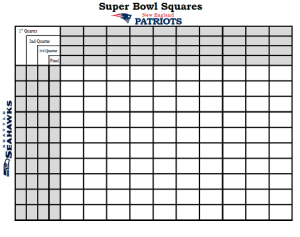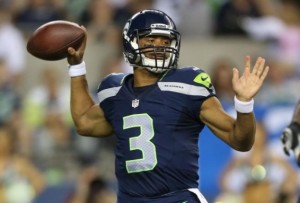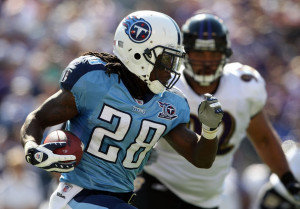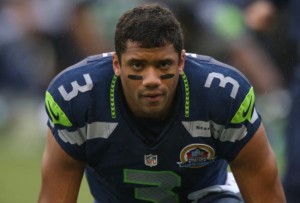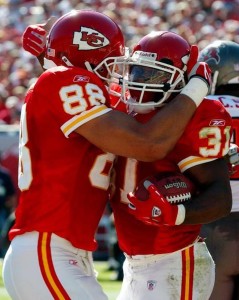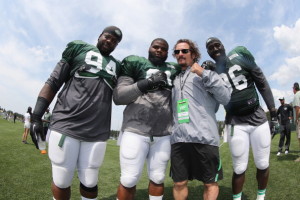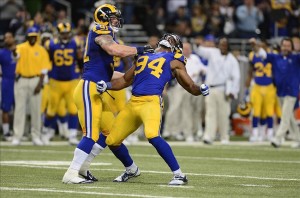In week 10, the Browns blew out the Bengals in the Andy Dalton Thursday Night Implosion game. A less-publicized factoid from that night: Cleveland became the first team in 2014 to record 50 rush attempts in a game. It was a true team effort on the ground, with Terrance West rushing 26 times for 94 yards, Isaiah Crowell going 12 for 41, and even Ben Tate gaining 34 yards on 10 carries. All three players rushed for a touchdown, too, and Brian Hoyer added four carries, bringing the total to 52 runs.
But in week 11, the Browns had 52 pass attempts in a loss to the Texans. As it turns out, calling 50 runs and 50 passes in consecutive weeks is pretty unusual. In fact, it’s only happened eight other times in NFL history.

2012 New England Patriots
Facing Peyton Manning and the Denver Broncos in week 5, New England dominated the game on the ground. The Patriots at one point led 31-7, allowing Stevan Ridley, Brandon Bolden, Danny Woodhead, and Shane Vereen to combine for 50 carries for a whopping 253 yards (Ridley (28/151/1) shouldered the largest load).
The next week, the Patriots helped bring Richard Sherman into the national spotlight. Tom Brady threw 58 passes as the Patriots lost 24-23 to Seattle.
1994 Pittsburgh Steelers
This was the first great season of the Bill Cowher era, and you won’t be surprised to learn that Pittsburgh finished 2nd in rush attempts and 1st in rushing yards in 1994. In the Steelers first playoff game — against Bill Belichick, Nick Saban, and the Cleveland Browns — Pittsburgh rushed 51 times for 238 yards. Barry Foster rushed for 133 yards on 24 carries, Bam Morris produced a very Morris-like stat line of 22/60, and fullback John L. Williams (of Seahawks fame) had two carries for 43 yards and a touchdown. Pittsburgh won comfortably, 29-9, which made what happened next so surprising.
In the AFC Championship Game against the Chargers the following week, Pittsburgh again enjoyed the lead for most of the day (Game Script of +3.9). But there, Foster gained just 47 yards on 20 carries, which led to a very pass-happy offensive approach. Neil O’Donnell finished 32 of 54 for 349 yards and 1 touchdown with no picks and was not sacked. But the Steelers, despite controlling the game and the clock (TOP of 37:13) wound up losing, 17-13.
1987 Cincinnati Bengals
In 1988, the Bengals had rookie Ickey Woods and Pro Bowler James Brooks lead the NFL’s best rushing attack. But in ’87, Woods was dominating at UNLV, while Brooks was still in San Diego. So in week 9 of the ’87 season, when the Bengals rushed 50 times, it was Larry Kinnebrew (27/100/1) and Stanford Jennings (12/91) leading the way, while Boomer Esiason also carried 10 times for 77 yards. The Bengals won in Atlanta that day, 16-10.
The following week against the Steelers, the ground game was not working, and Esiason dropped back an incredible 58 times. Esiason did throw for 409 yards, but took five sacks and was intercepted three times, as the Bengals fell, 30-16.
1986 Detroit Lions
The Lions and Packers were not very good 18 years ago, and staged a forgettable game back in week 6 of the 1986 season. Eric Hipple completed 15 of 19 passes but for only 102 yards. Fortunately for Detroit, the ground game was humming along just fine: Garry James (20/140/1) and James Jones (29/99) carried the day in Green Bay, leading the Lions to a 21-14 victory.
The next week in Anaheim, the Rams jumped out to a 14-0 first quarter lead; Jones and James would finish the day with just 57 yards on 22 carries. As a result, the game was in Hipple’s hands, and he went 31/50 for 316 yards and a touchdown. Those numbers aren’t bad, but Hipple was sacked twice and threw a pair of picks, including a pick six. Los Angeles threw just 12 passes all day, and held on to win, 14-10.
1985 New York Giants
The NFC East was up for grabs when the 9-5 Giants traveled to Dallas to take on the 9-5 Cowboys. Neither team ran the ball that efficiently, but the Giants went unusually pass-happy. Phil Simms had 55 dropbacks, completing 24 passes and taking five sacks, while throwing for 329 yards, 2 touchdowns, and 3 interceptions (including a pick six).
With the division title gone, New York needed to win in week 16 to make the playoffs. Simms threw just 16 passes, as the Giants rode Joe Morris to the tune of 36 carries for 202 yards and 3 touchdowns. As a team, the Giants rushed 51 times for 292 yards (excluding a pair of Simms kneeldowns), and blew out the Steelers, 28-10.
1984 Seahawks
Heading into the final weekend of the season, the Seahawks and Broncos were both 12-3. The teams squared off in Seattle for AFC West supremacy, just four weeks after Seattle won in Denver, 27-24. Things were different in the rematch: Denver won 31-24 despite John Elway going just 9 of 21 for 148 yards with 4 interceptions. The Seattle running game was ineffective, so Dave Krieg wound up dropping back 54 times, going 30 for 50 for 334 yards, with four sacks, two touchdowns, and two interceptions.
The loss put Seattle in the Wild Card round, and that’s when Ground Chuck took over. The Seahawks rushed 51 times for 204 yards … and completed just four passes! Dan Doornick rushed 29 times for 126 yards, while Krieg was limited to just 12 dropbacks. As you can imagine, the Seahawks defense came to play, shutting out Oakland for most of the game in a 13-7 victory.
1975 New Orleans Saints
In week 10 of the ’75 season, Archie Manning went 25 of 52 for 207 yards with no interceptions and two picks in a 16-6 loss to the 49ers. If you think 52 pass attempts (and four sacks) is a pass-heavy game plan for 1975, you are correct: it was the most pass-happy game of the season.
The next week, New Orleans jumped out to a 16-3 lead against the Browns in Cleveland, which seemed to dictate a change in strategy. Manning finished the day 6 of 10 for 92 yards, while Mike Strachan (21/99) and Alvin Maxson (16/45/2) powered the offense. The Saints finished with 177 rushing yards on 51 carries, but a late Cleveland rally turned it into a 17-16 Browns win.
1961 Houston Oilers
The early AFL Oilers teams were one of history’s great aerial attacks. In 1960, Bill Groman produced a 72/1473/12 stat line in 14 games, George Blanda guided the AFL’s top passing offense, and Houston won the AFL title. The following year, Houston averaged a whopping 36.6 points per game, Blanda threw for 3,330 yards and 36 touchdowns, Groman caught 17 touchdowns, and Charley Hennigan caught 82 passes for 1,746 yards and 12 touchdowns. And Houston again finished the season as the AFL champion.
But the 1961 season didn’t start the way you might think. In the opener against a bad Raiders team, Houston jumped out to a 28-0 lead before the half. As a result, Billy Cannon rushed 22 times for 82 yards, Charley Tolar added 101 yards on 18 carries, and the Oilers finished with 203 yards on the ground on 55 carries.
The next week, Houston lost to San Diego, an outcome the Oilers would avenge in the AFL Championship Game. After a 3-3 first quarter, Houston scored four touchdowns in the second quarter, putting the game out of hand. George Blanda finished 15/29 for 131 yards and 4 picks, while Jacky Lee came in and threw 25 times for 190 yards (with 3 touchdowns and 2 picks) in the second half. A week after rushing 55 times, the Oilers dropped back 57 times in the loss to San Diego.
The real question: why didn’t someone start crunching Game Scripts data in 1961?!


